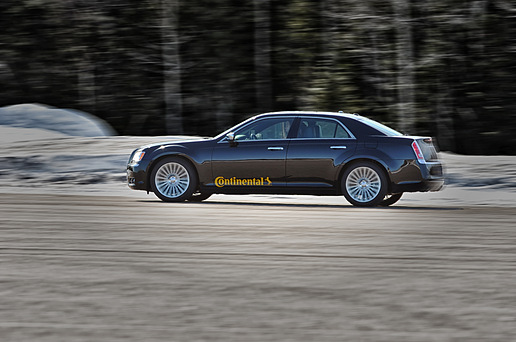 大陆汽车正在位于密歇根州Brimley的540英亩测试场(如图所示)及其他地方测试下一代高度自动驾驶示范车。(照片由Spencer Peeples拍摄)
大陆汽车正在位于密歇根州Brimley的540英亩测试场(如图所示)及其他地方测试下一代高度自动驾驶示范车。(照片由Spencer Peeples拍摄) 这是大陆汽车的技术发展线路图——从部分自动驾驶到高度自动驾驶,最后是完全自动驾驶。
这是大陆汽车的技术发展线路图——从部分自动驾驶到高度自动驾驶,最后是完全自动驾驶。
成功实现高度自动驾驶,所需的不仅是一系列先进技术,还需要一位随时准备待命的驾驶员。
“我们在下一代高度自动驾驶车辆上使用红外线驾驶员分析摄像头,为研发‘驾驶员模型’收集数据。该模型不仅能告诉我们驾驶员的注意力集中程度,还能预测其重新掌握驾驶的反应时间,”大陆汽车北美高级工程主管Ibro Muharemovic表示。
大陆汽车的第二代自动驾驶概念于上个月底对外公布。为此,大陆在其位于密歇根州Brimley的试验场举办了一场媒体技术前瞻会。首先,Muharemovic与《汽车工程》杂志共同开启了一个分为两阶段的驾驶演示。首先,他将车速提升至高速公路驾驶速度,接着他启动了全车速自适应巡航控制,并激活了高度自动驾驶模式。这辆经过特殊配置的2014MY克莱斯勒300对驾驶员的操作做出回应,自动将车速调至60 mph (97 km/h),并在下一个倾斜转弯口将车速降至46 mph (74 km/h) ,顺利通过,接着又在直行道上恢复到高速公路的车速。
自2014年8月起,美国的测试工程师们轮流坐上下一代示范车的驾驶座,让两台车内摄像头识别并跟踪驾驶过程中的面部活动,收集到的数据将用于计算机驾驶员模型的研发。
“现阶段我们只有一个非常初级的驾驶员模型,当驾驶员向前看时,系统认定驾驶员注意力是集中的,向侧面看时为不集中。但是计算反应时间是一项非常复杂的工程,因此我们需要海量的原始数据,” Muharemovic表示。
位于挡风玻璃底部的一条横跨仪表板的发光条可告知驾驶员当前的驾驶模式。该技术在大陆汽车的“驾驶员注意力识别汽车”上首次使用。(详见http://articles.sae.org/11842)
绿色表明当前使用的是驾驶员辅助与全速自适应巡航控制模式。蓝色则表明汽车处于高度自动驾驶模式。橙色为待机模式,意味着驾驶员正在掌控驾驶。“非常直观的视觉提示至关重要,” Muharemovic表示。
为了实现更接近人类驾驶员的自动驾驶风格,大陆汽车在第二代示范车上安装了高精度数字地图信息。
“高精度地图可以精确地反应道路环境。它能提供准确的信息,如车道数量,以及这些车道的弯道以及道路出口的确切位置等,” Muharemovic表示,“高精度地图的信息可帮助我们在道路环境中确定车辆的位置。”
大陆汽车的示范车配备了一系列传感技术。
下一代远程雷达可覆盖前方250米(820英尺)的距离,开角为120度。其视野为近距雷达的两倍,且覆盖距离比用于第一代示范车的第三代雷达还多出50米(165英尺)。 侧边安装了4个近距雷达,观测距离90米(295英尺),开角120度。此外,第二代示范车还增加了一个360度环境照相机系统。
下一代无人驾驶概念使用了一台安装在挡风玻璃上的前视立体照相机,用于侦测道路、识别行人、交通标志、迎面的车灯光束和其他物体。
充足的冗余
“立体照相机使用两套道路识别算法,分别由不同团队设计。只有这样做我们才能比较两套算法,并在传感器内添加冗余。” Muharemovic表示。
制动和转向系统也有备份,这是为了应对主系统发生问题时所设计的策略。除了驱动系统外,电力供应系统也设计了冗余。“比如说,前雷达用的是一套电力系统,立体照相机用的是另一套电力设备和通讯线路,” Muharemovic说。
大陆汽车在密歇根的奥本山上配备了3辆高度自动驾驶示范车。第一代示范车选用了大众的帕萨特。而目前的示范车则是两辆克莱斯勒300,其中一辆用作传感器融合/传感架构的研发平台,另一辆则用于研发制动与转向的冗余系统。
“我们的研发成果是全球共享的,所以当我们的德国或日本同事在某个传感器、系统或功能上取得了研究进展,我们都会把它带到这里来,而在这里获得的成就,也会分享给其他地区的团队。” Muharemovic表示。“我们的合作伙伴也在进行技术研发,他们研发成功后,我们也能够获益。”
Continental shows next-generation highly automated car
A highly autonomous driving vehicle needs a suite of advanced technologies and a ready-to-take-control driver.
“We’re using infrared driver analyzer cameras on our next-generation highly automated driving vehicle to collect data for the development of a ‘driver model.’ The driver model would tell us if the driver is attentive. And it would predict the driver’s reaction time to resume control of the vehicle,” said Ibro Muharemovic, head of Continental’s advanced engineering in North America.
Continental’s second-generation concept was featured during a media technology preview at the supplier’s Brimley, Michigan proving grounds late last month. Muharemovic began a two-lap driving demonstration with Automotive Engineeringby accelerating the vehicle to a highway speed. He then engaged the full-speed-range adaptive cruise control and activated the highly automated driving mode. The specially equipped 2014MY Chrysler 300 responded by autonomously driving at 60 mph (97 km/h), slowing to 46 mph (74 km/h) to navigate smoothly through a banked turn, then resuming highway speed through a straightaway.
Since August 2014, test engineers in the U.S. have been taking turns in the driver’s seat of the next-generation demonstrator as two in-vehicle cameras recognize and track facial movements during drive time. The accumulated data will aid in the development of a robust computer driver model.
“At this point, I only have a very early version of the driver model that indicates attentiveness when the driver is looking forward and inattentiveness when the driver is looking to the side. As for reaction time, that is a big, big undertaking. This is why we need lots and lots of raw data,” said Muharemovic.
A light bar running the length of the dashboard at the windshield’s base provides the driver a visual reminder of the current driving mode. The technology debuted on Continental’s Driver Focus Vehicle (see http://articles.sae.org/11842).
Driver assistance and full-speed adaptive cruise control engagement is indicated by a green light bar. When the light bar is blue, the vehicle is in the highly automated mode. An orange color indicates a stand-by mode, which means the driver is actively steering. “It’s important to have a straightforward, always visible way of knowing what driving mode the car is in,” Muharemovic said.
To facilitate a more human-like autonomous driving style, high-definition digital map information is being employed on the second-generation demonstrator.
“The HD map is a highly accurate representation of the road environment. It provides us with precise information, such as how many lanes there are, the exact curvatures of those lanes, and the exact location of roadway exits,” said Muharemovic, “HD map information helps us localize the vehicle on the road environment.”
Continental’s demonstrator is fitted with an array of sensing technologies.
Next-generation long-range radar looks forward 250 m (820 ft) with a 120-degree opening. That is double the field of view in the near range and an additional 50 m (165 ft) in the complete range compared to the third-generation technology used on the first-generation demonstrator. Four short-range radars look to the sides at 90 m (295 ft) with a 120-degree opening. The second-generation vehicle demonstrator also has a 360-degree surround view camera system, a feature the first-generation vehicle concept did not have.
The next-generation concept uses a windshield-mounted, forward-facing stereo camera for lane detection and to recognize pedestrians, traffic signs, oncoming high-beam headlights, and other objects.
Redundancies abound.
“The stereo camera has two lane recognition algorithms that were developed by two different teams. It was done that way so we can compare the outputs of each and get added redundancy in one sensor,” said Muharemovic.
There is redundant braking and steering in case something happens with the primary units. In addition to the actuation redundancies, there is redundancy with the power supply. “As an example, the front radar is on one power supply and the stereo camera is on another power supply and communication line,” said Muharemovic.
Continental has three highly autonomous demonstration vehicles in Auburn Hills, MI. First-generation technology was showcased on a Volkswagen Passat. Two Chrysler 300s are now part of the demonstration fleet, with one car being used as a development platform for sensor fusion/sensing architecture and the other car serving as a development platform for redundant braking and steering.
“We share development globally, so whenever my colleagues in Germany or Japan make an update to a sensor or a system or a function, we are able to bring it to this region and vice-versa,” said Muharemovic. “Our partner companies are also developing technologies and as those technologies become available, we’ll make the updates.”
等级
打分
- 2分
- 4分
- 6分
- 8分
- 10分
平均分
- 作者:Kami Buchholz
- 行业:汽车
- 主题:电气电子与航空电子
